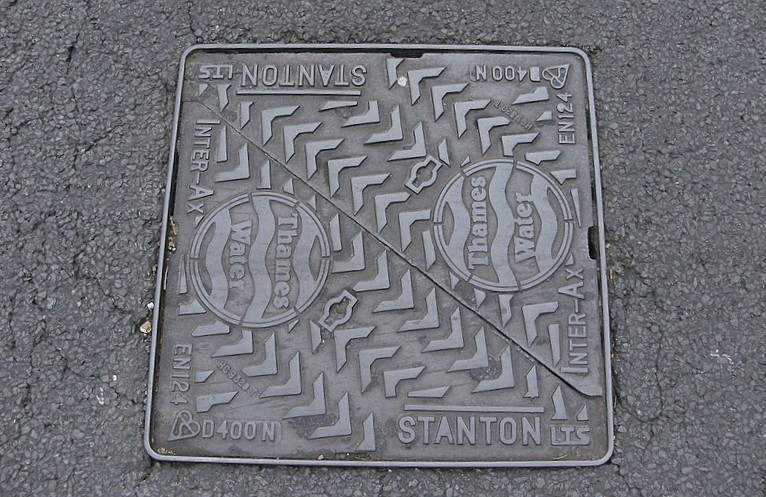Manhole cover
Contents |
[edit] Introduction
A manhole, also known as an inspection chamber, provides access to underground utilities, most commonly sewer systems. This enables operatives to undertake inspections, make modifications, and carry out cleaning and maintenance.
A manhole usually consists of a chamber or ring – a vertical circular pipe – of varying sizes and depths, which is used to access inspection points. The chamber is protected by a manhole cover (also referred to as a drain cover or the gender neutral term, maintenance hole cover) that is typically positioned away from the wheel line of traffic.
The cover acts as a removable 'plug' to protect the manhole and prevent unauthorised access. They can also be marked to identify the services (and affiliated maintenance entities) associated with them.
[edit] Manhole cover details
Evidence of manhole covers can be found as far back as ancient Rome. During this period, stone covers were used to cover limestone sewer grates.
Modern manhole covers are generally circular, but they can also be rectangular, triangular or square. Generally, covers fixed with manhole key holes, which must be free from debris.
Covers are typically made from metal or, less commonly, precast concrete, glass reinforced plastic or other composite materials. They are generally inexpensive to manufacture and are heavy enough to prevent unintended displacement (caused by traffic) or unauthorised removal (by thieves hoping to resell the scrap material for profit).
Most covers rest on a metal frame (or base) that has a smaller inset rim to fit the cover. This combination of cover and base is sometimes referred to as a casting.
[edit] Manhole cover sizes
Sewers for Adoption specifies that all manhole covers must be Kitemarked and comply with BS EN124 with Class D400 covers in areas used by road vehicles. It is recommended that all covers subject to traffic loading have 150 mm deep cover and frames fitted.
The cover and frame may rest on a cover slab, which can be made from concrete. Cover slabs must be positioned in square alignment with step irons or ladders and provide a minimum 600 x 600 sq. mm unobstructed opening. The internal face of the cover slab must be plumb with the outer edge of the step irons.
The size of manhole covers varies based on the dimensions of the opening. They commonly come in sizes from 300 mm x 300 mm to 1200 mm x 1200 mm (for square/rectangular covers) and 450 mm or 600 mm diameters for circular covers.
For 600 x 600 sq. mm openings on 1,050 mm diameter chamber rings and above, it is usual that a 600 x 750 mm cover slab is fitted, reduced to a 600 x 600 sq. mm opening by the use of an eccentric raising piece to suit the manhole cover and frame used. For 1,050 mm and 1,200 mm diameter rings less than 1.5 m deep to benching, 750 x 750 mm covers shall be fitted.
For 1,500 mm diameter rings less than 1.5 m deep to benching, 1,200 x 675 mm covers shall be fitted.
Cover slabs must not be cut to increase opening dimensions, as this will significantly weaken the cover slab.
[edit] Related articles on Designing Buildings Wiki
Featured articles and news
A change to adoptive architecture
Effects of global weather warming on architectural detailing, material choice and human interaction.
How big is the problem and what can we do to mitigate the effects?
Overheating guidance and tools for building designers
A number of cool guides to help with the heat.
The UK's Modern Industrial Strategy: A 10 year plan
Previous consultation criticism, current key elements and general support with some persisting reservations.
Building Safety Regulator reforms
New roles, new staff and a new fast track service pave the way for a single construction regulator.
Architectural Technologist CPDs and Communications
CIAT CPD… and how you can do it!
Cooling centres and cool spaces
Managing extreme heat in cities by directing the public to places for heat stress relief and water sources.
Winter gardens: A brief history and warm variations
Extending the season with glass in different forms and terms.
Restoring Great Yarmouth's Winter Gardens
Transforming one of the least sustainable constructions imaginable.
Construction Skills Mission Board launch sector drive
Newly formed government and industry collaboration set strategy for recruiting an additional 100,000 construction workers a year.
New Architects Code comes into effect in September 2025
ARB Architects Code of Conduct and Practice available with ongoing consultation regarding guidance.
Welsh Skills Body (Medr) launches ambitious plan
The new skills body brings together funding and regulation of tertiary education and research for the devolved nation.
Paul Gandy FCIOB announced as next CIOB President
Former Tilbury Douglas CEO takes helm.
UK Infrastructure: A 10 Year Strategy. In brief with reactions
With the National Infrastructure and Service Transformation Authority (NISTA).
Ebenezer Howard: inventor of the garden city. Book review.
Airtightness Topic Guide BSRIA TG 27/2025
Explaining the basics of airtightness, what it is, why it's important, when it's required and how it's carried out.






















